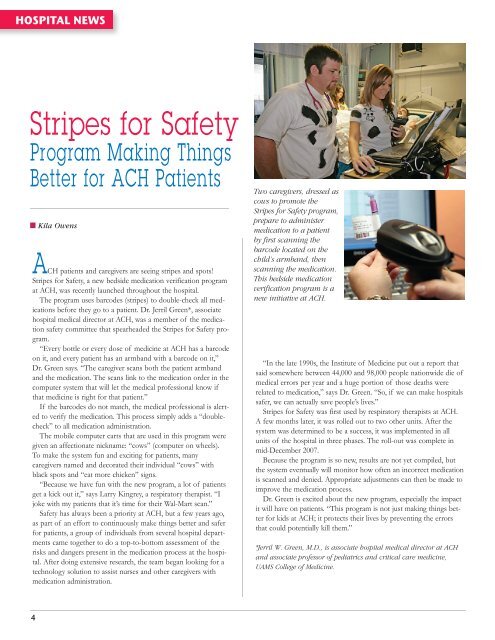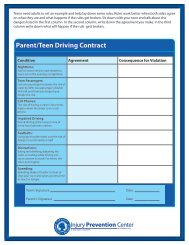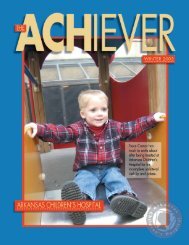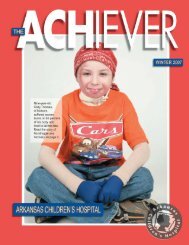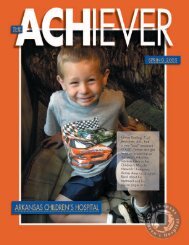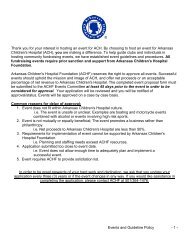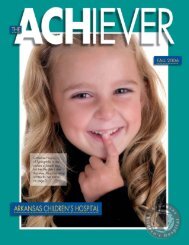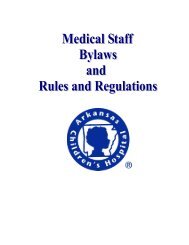HOSPITAL NEWSStripes for SafetyProgram Making ThingsBetter for ACH Patients■ Kila OwensACH patients and caregivers are seeing stripes and spots!Stripes for Safety, a new bedside medication verification programat ACH, was recently launched throughout the hospital.The program uses barcodes (stripes) to double-check all medicationsbefore they go to a patient. Dr. Jerril Green*, associatehospital medical director at ACH, was a member of the medicationsafety committee that spearheaded the Stripes for Safety program.“Every bottle or every dose of medicine at ACH has a barcodeon it, and every patient has an armband with a barcode on it,”Dr. Green says. “The caregiver scans both the patient armbandand the medication. The scans link to the medication order in thecomputer system that will let the medical professional know ifthat medicine is right for that patient.”If the barcodes do not match, the medical professional is alertedto verify the medication. This process simply adds a “doublecheck”to all medication administration.The mobile computer carts that are used in this program weregiven an affectionate nickname: “cows” (computer on wheels).To make the system fun and exciting for patients, manycaregivers named and decorated their individual “cows” withblack spots and “eat more chicken” signs.“Because we have fun with the new program, a lot of patientsget a kick out it,” says Larry Kingrey, a respiratory therapist. “Ijoke with my patients that it’s time for their Wal-Mart scan.”Safety has always been a priority at ACH, but a few years ago,as part of an effort to continuously make things better and saferfor patients, a group of individuals from several hospital departmentscame together to do a top-to-bottom assessment of therisks and dangers present in the medication process at the hospital.After doing extensive research, the team began looking for atechnology solution to assist nurses and other caregivers withmedication administration.Two caregivers, dressed ascows to promote theStripes for Safety program,prepare to administermedication to a patientby first scanning thebarcode located on thechild’s armband, thenscanning the medication.This bedside medicationverification program is anew initiative at ACH.“In the late 1990s, the Institute of Medicine put out a report thatsaid somewhere between 44,000 and 98,000 people nationwide die ofmedical errors per year and a huge portion of those deaths wererelated to medication,” says Dr. Green. “So, if we can make hospitalssafer, we can actually save people’s lives.”Stripes for Safety was first used by respiratory therapists at ACH.A few months later, it was rolled out to two other units. After thesystem was determined to be a success, it was implemented in allunits of the hospital in three phases. The roll-out was complete inmid-December 2007.Because the program is so new, results are not yet compiled, butthe system eventually will monitor how often an incorrect medicationis scanned and denied. Appropriate adjustments can then be made toimprove the medication process.Dr. Green is excited about the new program, especially the impactit will have on patients. “This program is not just making things betterfor kids at ACH; it protects their lives by preventing the errorsthat could potentially kill them.”*Jerril W. Green, M.D., is associate hospital medical director at ACHand associate professor of pediatrics and critical care medicine,UAMS College of Medicine.4
PATIENTSJillian ChaneyChooses to Give to Othersin the Midst of Personal Tragedy■ Kila OwensJillian wants to take a dance class. Or an art class. Or play soccerwith kids her age. But she can’t because she might get sick.Jillian Faith Chaney, a 5-year-old from Mena, was diagnosed atthe age of 3 with aplastic anemia, a condition where bone marrowdoes not produce sufficient new cells to replenish blood cells. Aspart of her immune suppression treatment, she cannot be aroundher peers because for her, an infection, bacteria or even the commoncold could be deadly.In January 2006, 3-year-old Jillian fell and bumped her nose. Herparents, Sheli and Fred, initially thought her nose was broken.When they took her to the local hospital, doctors were more concernedthat the bleeding could not be controlled.Jillian was flown immediately to Little Rock on Angel One, theACH helicopter. Once at ACH, she underwent several tests formany blood-related diseases, including leukemia. As doctors narrowedthe results down, Sheli grew more concerned.After a month of outpatient tests, a clear diagnosis was finallymade – Jillian had aplastic anemia. Jillian and her family wereshocked and somewhat relieved at the diagnosis.“We were so incredibly relieved that her diagnosis was notleukemia,” Sheli says. “When we realized what aplastic anemia was,however, we were heartbroken. We realized, though, that it couldbe much worse.”Doctors began treatment immediately, which includedchemotherapy and immune suppression. Jillian’s diagnosis and subsequenttreatment impacted her entire family.“It has changed our life in many ways,” Sheli says. “First, in howwe go about our daily life. Every cough or sniffle causes us to fearfor her safety. It has also changed our attitude toward life. We donot take the little things for granted – running to the store formilk, playing catch, going to school. Every little thing is a celebration.”Her treatment continued through January 2007, when she wentinto remission. Jillian, Sheli, Fred and older brother David rejoiced.Finally, Jillian would get to do the things she always wanted to do.Her parents enrolled her immediately in dance class and happilycelebrated the end of Jillian’s sickness. In August, Jillian was readyto enter kindergarten at the local public school, when she and Shelimade a trip to ACH for a routine check-up.Jillian, who has been a patient at ACH since 2006,has remained positive and upbeat through tworounds of treatment for aplastic anemia.They received some very disappointing news.Jillian’s symptoms were back and she would need anotherround of treatment. She had a high-grade fever that lastedfive days. Her parents were worried, frightened and dealingwith a disappointed little girl.“We were absolutely devastated when we found out shehad relapsed,” Sheli says. “We were so sure she was going tobe okay after she went into remission. I just hurt for her somuch, knowing that she would miss out on so much. She hadbeen through enough.”After the initial disappointment, Jillian has remained strongand upbeat. She is still undergoing treatment at ACH twice aweek and is being home schooled by her mother, who isamazed that her little girl is able to stay so positive.“Jillian Faith is an amazing little girl, and she inspires us tobe better than what we are,” Sheli says. “Through all that shehas been through, she still thinks of others and always wantsto give.”Jillian and her mother recently presented <strong>Arkansas</strong>Children’s <strong>Hospital</strong> with $731 to benefit patients and familieswho visit the cancer clinic at ACH.Jillian and David collected change from family, friends andothers in her community to help the families of other childrenwho visit the clinic. The money will go to a fund thathelps families pay for food, gas and other expenses.John Bel, president of the ACH Foundation, was delightedat the donation. “What a heartfelt gift,” he says. “We can alllearn a lesson from this 5-year-old girl who, in the midst of herown tragedy, continues to think of others.”5


